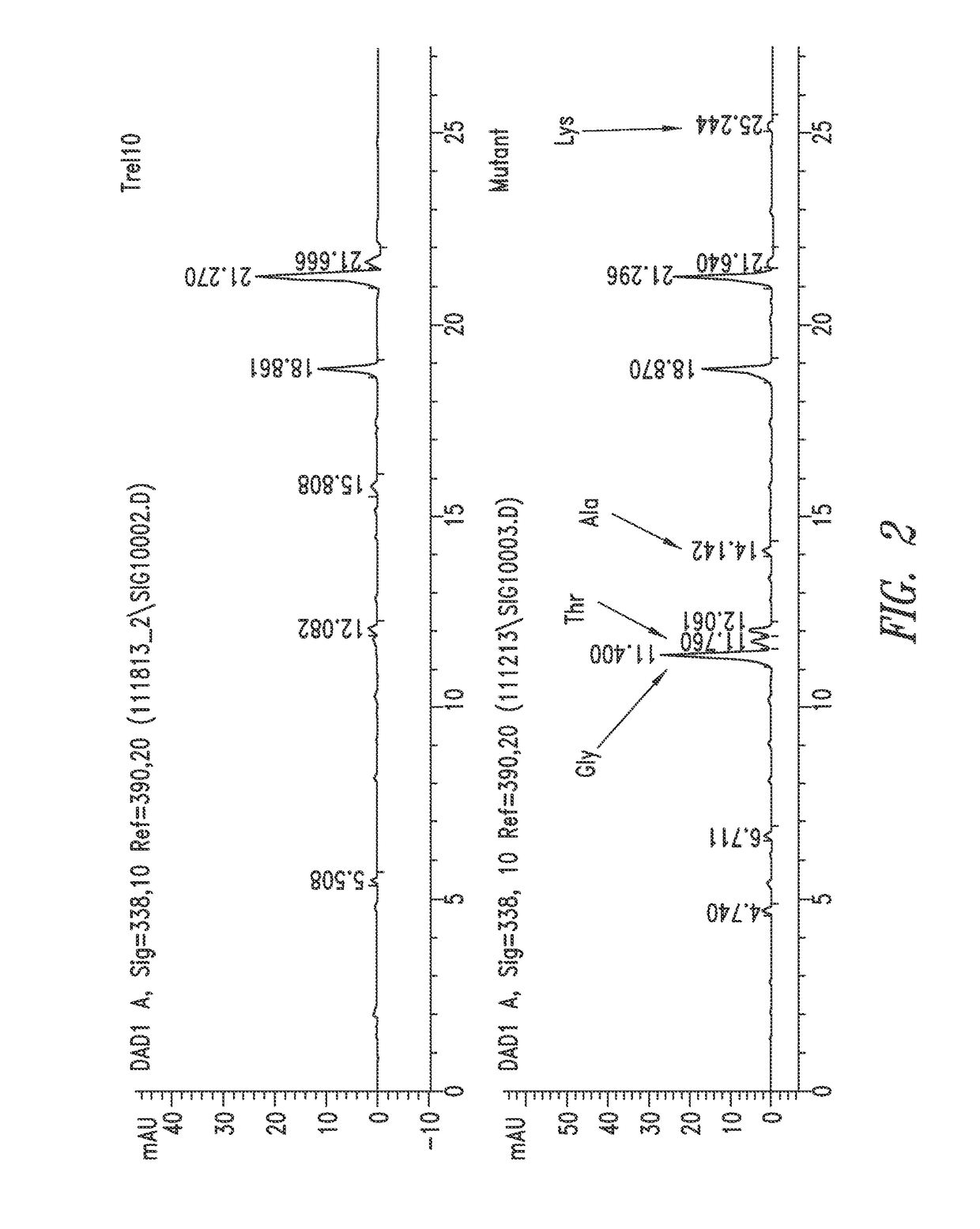Compositions and methods for biological production of amino acids in hydrogenotrophic microorganisms
a technology of hydrogenotrophic microorganisms and amino acids, which is applied in the direction of lyases, carbon-nitrogen lyases, transferases, etc., can solve the problems of limited extraction importance, increased carbohydrate feedstock cost, and environmental damage to byproducts, so as to achieve the effect of increasing activity
- Summary
- Abstract
- Description
- Claims
- Application Information
AI Technical Summary
Benefits of technology
Problems solved by technology
Method used
Image
Examples
example 1
Lysc Mutants of Hydrogenotrophic Microorganisms
[0175]A first step is to isolate feedback resistant lysC (aspartokinase) mutants of M. maripaludis. For example, one or more specific mutations are engineered into the aspartokinase gene of M. maripaludis or spontaneous aspartokinase mutants are identified by exposing a wild-type or parent M. maripaludis to a toxic lysine analog, such as S-2-aminoethyl-L-cysteine (AEC), and identifying M. maripaludis capable of growing in the presence of (resistant to) AEC. The resistance to a toxic analog may be spontaneous, or may be induced using a mutagen, such as EMS. The toxic analog may be combined with other amino acid analogs, such as methionine or threonine, or may be used alone, to select for M. maripaludis mutants resistant to the toxic analog. Additionally, aspartokinase having feedback resistance (deregulated) is selected by identifying mutants that are no longer susceptible to growth inhibition in the presence of regulatory agents, such a...
example 2
Amino Acid Overproducing Hydrogenotrophic Microorganisms
[0182]An initial step is to identify lysC mutants as described in Example 1. A second step to overproduce lysine is to inactivate pathways downstream of the lysine branch. For example, homoserine dehydrogenase, or any gene downstream of homoserine dehydrogenase, is inactivated, which can include genes for threonine biosynthesis and / or methionine biosynthesis. Inactivation or reduced activity is done by gene deletion, or by selecting for homoserine, threonine, and / or methionine auxotrophs by spontaneous mutation or chemically induced mutation, as described herein.
[0183]Optionally, any gene of the lysine biosynthetic pathway is overexpressed, including lysC, deregulated lysC, asd, dapA, dapB, dapL, lysA or any combination thereof. For example, a native promoter is replaced with one or more stronger promoters or by supplying additional copies of the gene expressed by its native promoter, or both. For example, the histone-like prom...
example 3
Uracil Phosphoribosyltransferase Deletion and Repa Insertion in Hydrogenotrophic Microorganisms
[0185]In order to improve plasmid transformation efficiency, lysC mutant Methanococcus maripaludis Trel10-Mut333 was modified on the genomic level by replacing the uracil phosphoribosyltransferase (upp) gene (Locus MMP0680) with the gene encoding replication protein A (repA, with its own promoter), referred to as Trel10-333UR. The repA allows for efficient transformation of any plasmid having repA, such as a plasmid derived from or based on the repA-containing pURB500 plasmid (see Tumbula et al., J. Bacteriol. 179:2976, 1997). The loss of uracil phosphoriboxyltransferase activity gives the modified M. maripaludis a 6-azaurcil resistance phenotype.
[0186]Briefly, the repA gene was amplified (along with its promoter) from the genomic DNA of Methanococcus maripaludis S001 (Walters et al.,App. Environ. Microbiol. 77:2549, 2011) with primers TKH_038 (5′aaattatgaggcgcgcctccctgaagaagaagagag3′, SEQ...
PUM
| Property | Measurement | Unit |
|---|---|---|
| Fraction | aaaaa | aaaaa |
Abstract
Description
Claims
Application Information
 Login to View More
Login to View More - R&D
- Intellectual Property
- Life Sciences
- Materials
- Tech Scout
- Unparalleled Data Quality
- Higher Quality Content
- 60% Fewer Hallucinations
Browse by: Latest US Patents, China's latest patents, Technical Efficacy Thesaurus, Application Domain, Technology Topic, Popular Technical Reports.
© 2025 PatSnap. All rights reserved.Legal|Privacy policy|Modern Slavery Act Transparency Statement|Sitemap|About US| Contact US: help@patsnap.com


